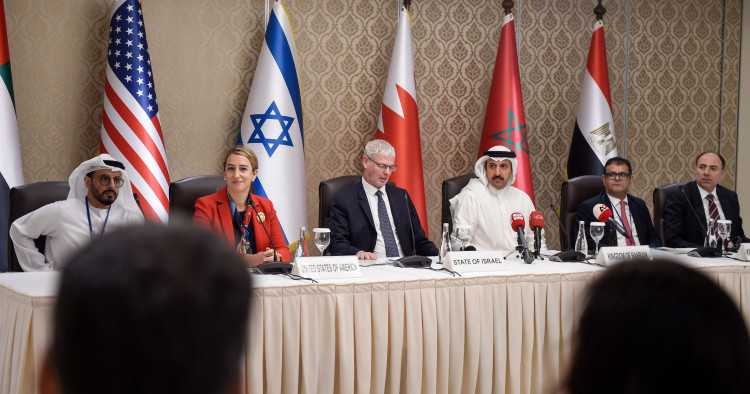With the Israel-Hamas conflict well into its sixth week, the international focus is increasingly shifting to what is to come the day after the shooting stops. This certainly means an urgent effort to help Palestinian civilians in Gaza rebuild their lives, ensure access to essential humanitarian supplies, and provide critical services, including health and education. It also means locating and recovering the Israeli hostages taken by Hamas on Oct. 7. Certainly, the situation in Gaza will never be restored to the status quo ante.
But Oct. 7 also sounded the death knell of the Abraham Accords as initially championed by the Trump administration and latterly embraced by the Biden administration. As originally conceived, Israeli and U.S. leaders believed an “outside-in” approach would allow Israel to normalize its relations with the Arab world while side-stepping the conflict with the Palestinians. It’s clear, however, that resolving that conflict remains central to establishing broader regional peace and stability. In recent days, the Biden administration’s rhetoric has shifted to acknowledge that reality. President Joe Biden alluded to it in comments to reporters when he asserted, “…when this crisis is over, there has to be a vision of what comes next, and in our view it has to be a two-state solution.”
That said, end to the initial conceit of the Abraham Accords does not mean an end to the essential role that the Abraham Accords partners can play in helping broker an Israeli-Palestinian agreement. There are precedents, of course, for Middle East conflicts serving as catalysts for peace talks. One potential model for what comes next could be the multinational Madrid Conference organized in October 1991, following the first Gulf War. Hosted by Spain and co-sponsored by the United States and the former Soviet Union, the conference brought together delegations from Israel, the Palestinians, Jordan, Lebanon, and Syria. Although the conference itself did not produce any political breakthroughs, it did launch individual follow-on processes that eventually led to the Israel-Jordan peace treaty and the Oslo process that created a roadmap for Israeli-Palestinian peace.
In addition to the bilateral tracks, the Madrid Conference created a separate, multilateral track that focused on regional issues, including water, the environment, arms control, refugees, and economic development. That second track garnered participation from across the Arab world and succeeded in advancing intra-regional cooperation, including between Arab states and Israel, on core cross-cutting issues like the Middle East Desalination Research Center, based in Muscat, Oman.
In fact, the second track can be seen as a precursor to the Negev Forum launched by the Abraham Accords partners in March 2022. Working groups organized by the Negev Forum partners first met in Abu Dhabi earlier in 2023 to encourage cooperation, advance common interests, and promote regional stability and prosperity in the Middle East. The groups focused on energy, health, tourism, food, and water. While the founding members were the governments of Bahrain, Egypt, Israel, Morocco, the United Arab Emirates, and the U.S., an explicit objective of the working groups was to strengthen the Palestinian economy and improve the quality of life for Palestinians. Expansion of the Negev Forum mandate to include final status issues along the lines of Madrid, particularly refugees, could further its explicit charge to generate momentum toward a resolution of the Israeli-Palestinian conflict and the achievement of a just, lasting, and comprehensive peace.
Beyond the multilateral engagement on aspects of the peace process, the Abraham Accords partners can also play an essential role in helping to bridge the gap between the Israelis and Palestinians. Speaking to The Guardian in late October, Palestinian Prime Minister Mohammed Shtayyeh noted Saudi Arabia had demanded that any normalization agreement with Israel produce substantive benefits for the Palestinians. Anticipating the emergency Arab summit, which was eventually held on November 11, Shtayyeh predicted that the Saudi position would be the common Arab position. The Abraham Accords partners “are talking to us,” Shtayyeh said, “and we and they want to engage.” Coordinating on a common Arab position that can advance dialogue with the Israelis can bring important benefits to the negotiations.
At the moment, of course, a political resolution to end the Israeli-Palestinian conflict remains on the distant horizon. Once military operations end, Israelis and Palestinians alike, traumatized by the horrific events of the past weeks, will need time to heal and repair the damage done. Failures of leadership in both Jerusalem and Ramallah will need to be held to account. Hopefully, both sides will bring forward new leaders who are willing as well as able to make the concessions and compromises necessary to reach a permanent peace. But there is no need to wait for the shooting to stop to begin the process. The Biden administration should announce now that it is preparing invitations to launch a new multilateral process, inviting representatives of Israel, Palestine, the United Nations, European Union, United Kingdom, and regional Arab partners to come to Washington to meet and begin preparations for negotiations. It is essential that Israelis and Palestinian now see that the horrors of October 2023 can be overcome and that the door can be opened to a more hopeful, peaceful future now and for the generations to come.
Amb. (ret.) Gerald Feierstein is a distinguished senior fellow on U.S. diplomacy at the Middle East Institute (MEI) and director of its Arabian Peninsula Affairs Program.
A version of this article first ran in The Hill.
Photo by MAZEN MAHDI/AFP via Getty Images
The Middle East Institute (MEI) is an independent, non-partisan, non-for-profit, educational organization. It does not engage in advocacy and its scholars’ opinions are their own. MEI welcomes financial donations, but retains sole editorial control over its work and its publications reflect only the authors’ views. For a listing of MEI donors, please click here.













